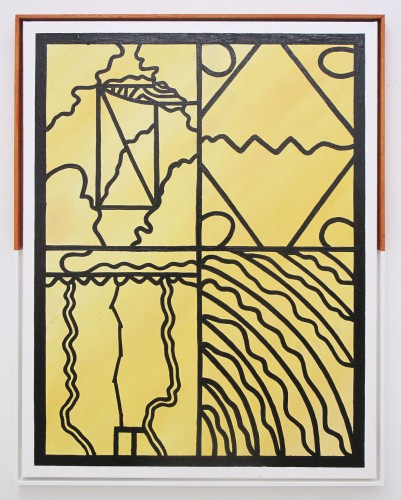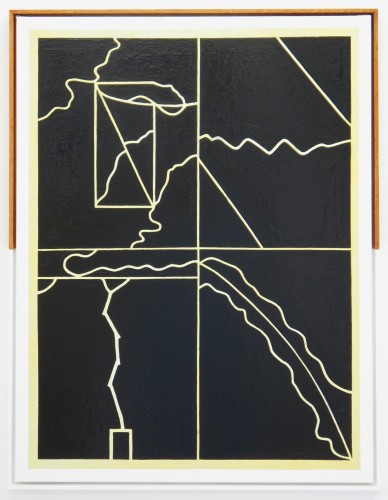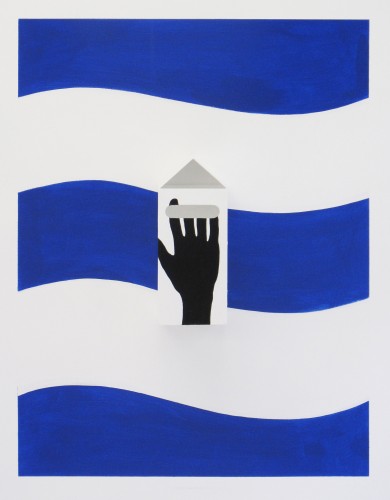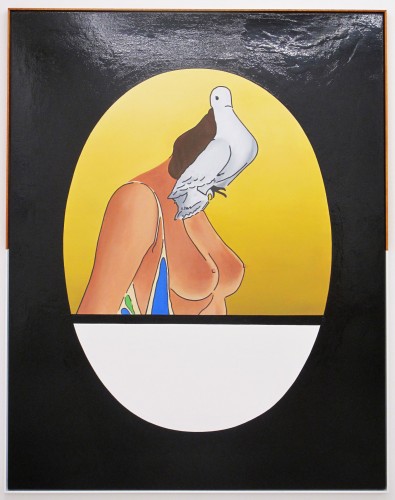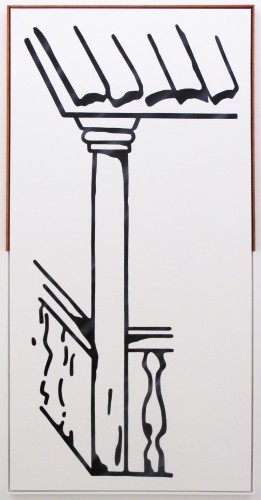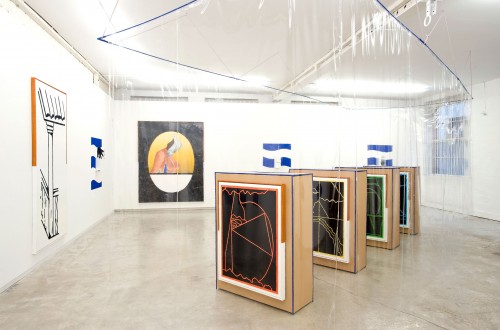Thomas Jeppe’s new body of work comprises a series of ‘reconstruction’ paintings and sculptures presented within and outside the ghost of a shipping container. The works ponder the value of research and the validation of a conceptual position through the gruelling hunt for facts, the earnest role of aesthetics in the communal greater good, and the critical potential of the Canary Islands, a Spanish colony off the coast of the Sahara Desert.
On the hunt for the real-world index of Social Realism, following suggestive clues mapped out on a sardine packet, Jeppe travelled to Corralejo on the island of Fuerteventura. Described as a sleepy traditional fishing village, Jeppe expected to find a community unified by its workforce, tied by visceral bonds of labour and environment, a functioning nostalgic cultural theme park operating in real-time. He instead discovered a monopolising tourism industry set amongst decaying abandoned real estate ventures – a town shaped by foreign influence, transient citizenship and economic necessity. The buildings, stemming from Spanish architectural foundations, but tapered by available materials and temporal aesthetic mores, came to rest at a pragmatic postmodernism. The shop signage, repurposed as businesses launched and folded, spoke of a resourcefulness endemic to life on an island. And the one town artist, a sincere role-fulfiller in the mould of Picasso, who produced a stream of sexy-surreal local/fantasy landscapes from a beachfront studio on the edge of the village.
Jeppe began this journey considering Social Realism as cliché, contingent on exaggeration, reduction and distillation, and always anchored in daily life. It speaks of greater truths, and it presents something to believe in. The search for the source of Social Realism, an abstract objective at best, could reveal only its counterpart – somewhere between openly universal and dramatically specific; always accessible and pedestrian, prosaic; stark, barren; honest, trapped of its time, and pure – Seaside Vernacular is the reality.
The exhibition will be accompanied by an artist book entitled Don Carlos, in which Jeppe interviews the owner of Mexico’s biggest seashell collection, published by Surpllus. Jeppe graduated from a BA in Cultural Studies, Curtin University, 2004; a BA in Cultural Studies (Honours), The University of Melbourne, 2005; and a Master of Visual Art, Victorian College of the Arts, 2011. Solo and joint exhibitions include EP, with Max Brand, Austin, Texas, 2013; ASIATISCHE ADLERNASE, Galerie Conradi, Hamburg, 2012; Boon at the Hand of Circumstance, DB Project, Sydney, 2012; Nature of Submission, Museum of Natural Mystery, Perth, 2012; ACAPONETA 1891, Curro Y Poncho, Guadalajara, Mexico, 2012; Exercise in Sophistication, with Caleb Shea, Utopian Slumps, Melbourne, 2011; Idiot’s Promenade, VCA Master Exhibition, Melbourne, 2011; Heinous Armani, with Gian Manik, TCB Art Inc, Melbourne, 2011; Cirrhosis By The Sea, Family Gallery, Los Angeles, 2011; The People’s Poet, with Thomas Baldischwyler, Galerie Conradi, Hamburg, 2010; Take The Edge Off, Black and Blue Gallery, Sydney, 2009; and The Height of Elegance, Utopian Slumps, Melbourne, 2009. Selected group exhibitions include L.A. Contemporary, Curro Y Poncho, Los Angeles, 2013; NADA Art Fair, Curro Y Poncho, Miami, 2012; NADA Art Fair, Curro Y Poncho, Miami, 2011; REMIX, Art Gallery of Western Australia, Perth, 2011; Explaining Colours to the Blind, Tristian Koenig, Melbourne, 2011; INDEX, Hamburg Kunsthaus, Hamburg, 2010; Applied Phlebotinum, curated by Andrew Tetzlaff and Julian White, Upstairs at the Napier, Melbourne, 2010 and The Corridor to Success, The Composing Rooms, London, 2010. Jeppe was recipient of the VCA Masters Nellie Castan Award in 2011. His work is held in the Art Gallery of Western Australia and Artbank collections, as well as private collections in Australia and overseas.
